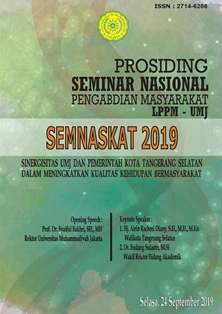PENINGKATAN PEMAHAMAN KALKULUS MELALUI SIMULASI DAN GRAFIK
Abstract
Kalkulus merupakan ilmu yang sangat penting dalam memahami ilmu ilmu lain yang berkaitan dengan teknik elektro. Mahasiswa terkadang mengalami kesulitan untuk memahami fungsi fungsi terutama fungsi 3 dimensi sehingga simulasi dan grafik dianggap bisa membantu. Pembelajaran tentang kalkulus dengan memakai simulasi dan grafik telah dilaksanakan. Hasil menunjukkan bahwa setelah diberikan simulasi dan grafik, terlihat peningkatan yang sangat signifikan pada jumlah mahasiswa yang dapat menjawab soal-soal yang diberikan dengan benar.References
Arganbright, D. E. (2014). Metric Spaces and Their Geometries via Excel. Electronic Journal of Mathematics & Technology, 8(5).
Chandrakantha, L. (2014). Learning ANOVA concepts using simulation. Proceedings of the 2014 Zone 1 Conference of the American Society for Engineering Education, 1–5. IEEE.
Drayton, B., Falk, J. K., Stroud, R., Hobbs, K., & Hammerman, J. (2010). After installation: Ubiquitous computing and high school science in three experienced, high-technology schools. Journal of Technology, Learning, and Assessment, 9(3), n3.
Jaakkola, T., & Nurmi, S. (2008). Fostering elementary school students’ understanding of simple electricity by combining simulation and laboratory activities. Journal of Computer Assisted Learning, 24(4), 271–283.
Kadry, S. (2011). Performance Evaluation of Using Excel to Study Calculus. International Journal of Research and Reviews in Computer Science, 2(2), 278.
Kruschke, J. K. (2005). Excel workbooks that generate sampling distributions from arbitrary populations for any sample statistic: An overview and invitation.
Lee, W.-P., & Hwan, C.-L. (2015). A computer simulation in mechanics teaching and learning: A case study in circular motions. Computer Applications in Engineering Education, 23(6), 865–871.
Radulović, B., Stojanović, M., & Županec, V. (2016). The effects of laboratory inquire-based experiments and computer simulations on high school students’ performance and cognitive load in physics teaching. Inst. Pedagos. Istraz, 48, 264–283.
Rochintaniawati, D., Agustin, R. R., & Sanjaya, Y. (2017). Development Of Self Construction Animation Software To Improve The Quality Of Science Instructional In Junior High School. International Conference on Mathematics and Science Education. Atlantis Press.
Rutten, N., Van Joolingen, W. R., & Van der Veen, J. T. (2012). The learning effects of computer simulations in science education. Computers & Education, 58(1), 136–153.
Shellman, S. M., & Turan, K. (2006). Do simulations enhance student learning? An empirical evaluation of an IR simulation. Journal of Political Science Education, 2(1), 19–32.
Tawil, M., & Dahlan, A. (2017). Developing Students’ Creativity through Computer Simulation Based Learning in Quantum Physics Learning. INTERNATIONAL JOURNAL OF ENVIRONMENTAL & SCIENCE EDUCATION, 12(8), 1830–1845.
Widder, M., & Gorsky, P. (2013). How students use a software application for visualizing 3D geometric objects to solve problems. Journal of Computers in Mathematics and Science Teaching, 32(1), 89–120.
Willis, V. F. (2016). A model for teaching technology: Using Excel in an accounting information systems course. Journal of Accounting Education, 36, 87–99.

